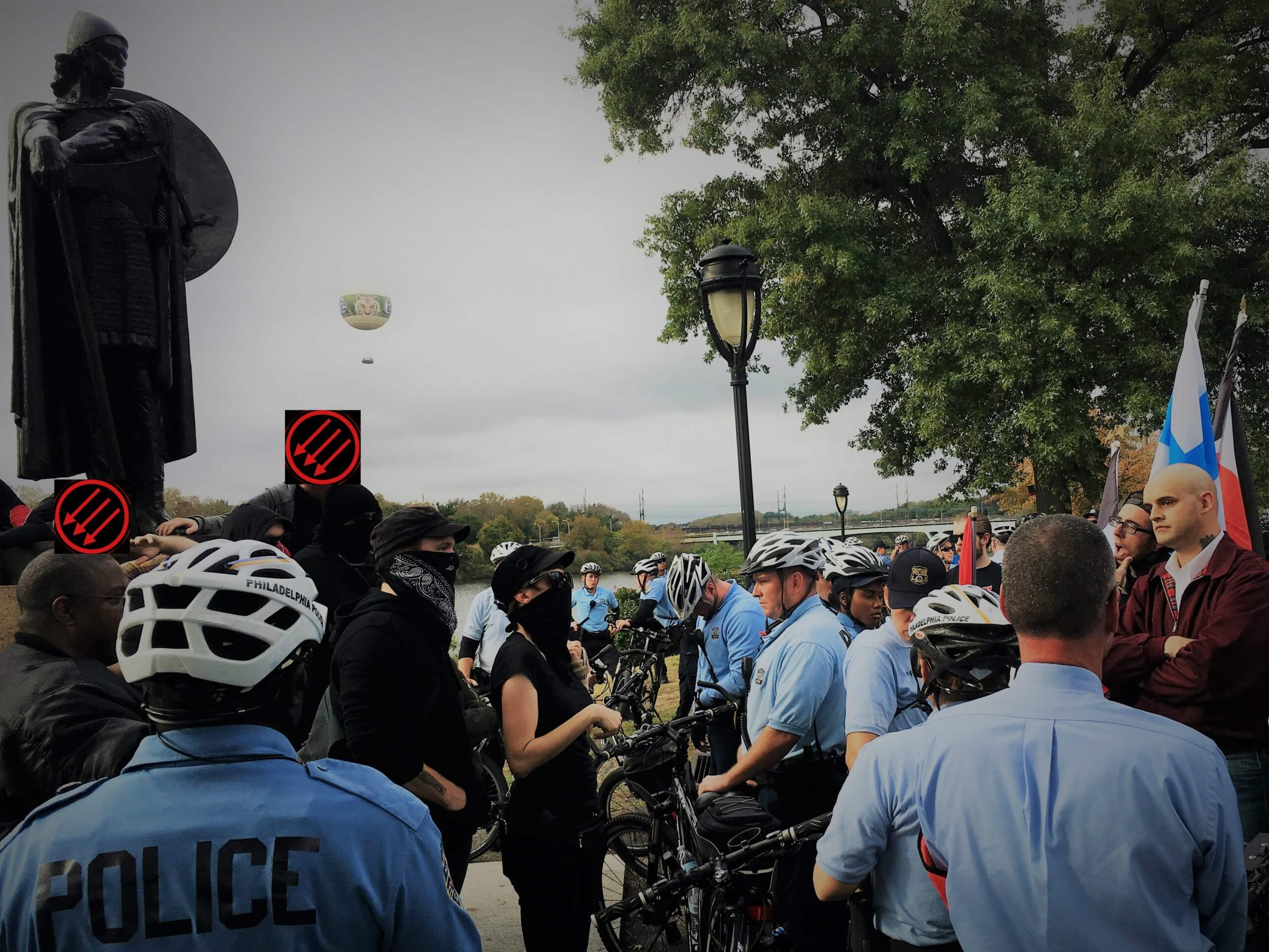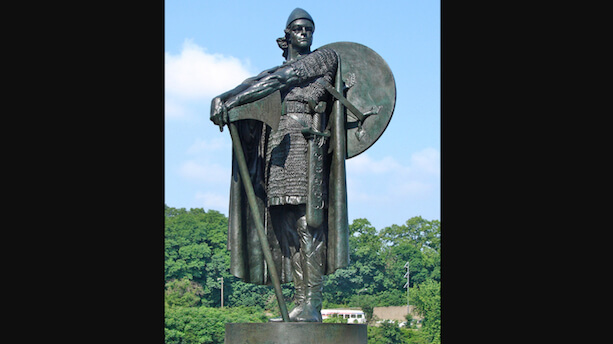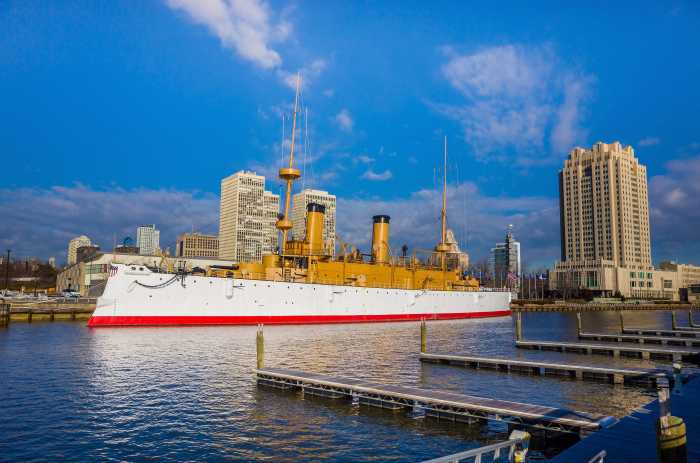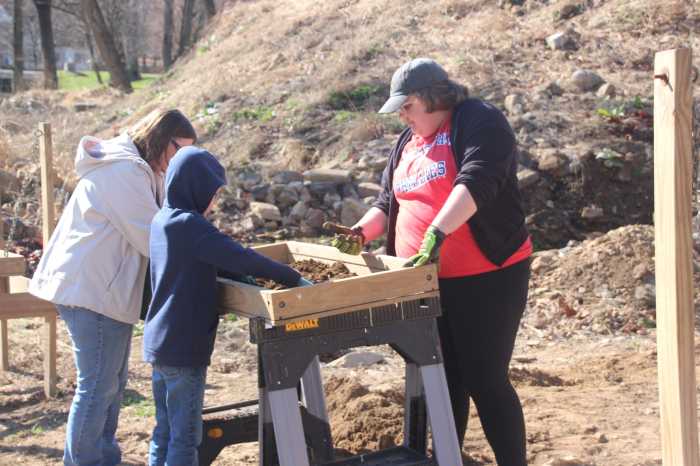A 12,000-pound, century-old statue of a Viking explorer along the Schuylkill River that some white supremacists group treat as a totem of their ideology is under repair after it was knocked down overnight. The 7-foot-4-inch tall bronze statue depicting Thorfinn Karlsefni is located next to the lighthouse at the end of Boathouse Row, beside Kelly Drive.
Around 2:30 a.m. Tuesday, police were called to the scene based on reports that the statue was missing. They found it in the river nearby.
“This statue was essentially toppled,” said Margot Berg, Public Art Director for Philadelphia’s Office of Arts, Culture and the Creative Economy (OACCE).”It was an act of vandalism. There aren’t really any cameras around there that we can see, so we’re hoping if anybody driving by saw anything, that they can help and share it with the police.”
The Schuylkill is not too shallow at that location, so the statue was clearly visible submerged in the water nearby. The pedestal was partly broken into two pieces. On Tuesday evening, it was lifted from the river and sent to a conservators. Workers found the statue decapitated in the river after being knocked over, but were also able to recover the head.
Viking statue lost his head when tossed into the river by vandals. pic.twitter.com/b5BQFYUNG3
— sarahbloomquist (@sarahbloomquist) October 2, 2018
Rowers tell us they use the Viking statue as a landmark so they know when to spin their boat and turn around. pic.twitter.com/3rjh2r8ZI5
— Tim Jimenez (@TimJRadio) October 2, 2018
#LATEST: Crews remove 1,000-pound Viking statue that was toppled into Schuylkill River by vandals https://t.co/ZLwPbO0vUH pic.twitter.com/Lc9qsB7qjS
— CBS Philly (@CBSPhilly) October 2, 2018
Police have not made any arrests or speculated on a motive for the statue being knocked down. Some have noticed that with an Eagles-Vikings game scheduled for Oct. 7, maybe a passionate football fan wanted to make a statement against the rival team.
But it’s not hard to connect the dots for those who know the statue’s history.
Viking statue appropriated by skinheads
The 98-year-old sculpture by artist Einar Jónsson memorializes the millennia-old journey to North America of Icelandic sailor Thorfinn Karlsefni, made around the year 1010 A.D.. But in recent years, the statue’s story has been perverted by white supremacists who have made it their rendezvous point for annual gatherings.
Specifically, the Keystone State Skinheads (KSS), now sometimes called Keystone United, have held annual meetings in Philadelphia on “Leif Erikson Day” by the statue for years, purportedly because they see the Vikings who visited North America as vindicating their white-supremacist ideology. The official date for that holiday is Oct. 9 – next week.
“If this was due to somebody on the left, on our side, it was based on the frustration people have about the non-actions against KSS every year when this happens, not talking about this, not talking about stopping it,” Daryle Lamont Jenkins, the activist who tracks white supremacist activities and founder of OnePeoplesProject.org, said of the statue’s toppling. “Let’s be fair. It’s just a statue of a Viking explorer. There really wasn’t any white supremacist connotation to it until KSS came along. … There should be a response. They should condemn it. Just say they [KSS] have no place in Philly. That’s all anybody really wants folks to do.”
Berg declined to comment on possible ideological or political motivations of the vandals who knocked down the Viking, which she called a beloved landmark for rowers and other Schuylkill River Trail users.
“The sculpture has been a flashpoint between different groups in the past, but I certainly can’t surmise why they did this last night,” Berg said. “It is a sculpture that has stood there for 100 years, and it is one of the parts of our collection which belongs to everyone. I’m just always really disappointed when people do these unnecessary and costly acts of vandalism.”

Antifa and skinheads face off by the statue on Leif Erikson Day 2017. Credit: phillyantifa.org
How a Viking statue became a neo-Nazi meeting place
Jenkins said he doesn’t know who took the statue down, but has heard others speculate it was vandals aligned with left-wing, anarchist or Antifa movements. One year ago, just ahead of last year’s Leif Erikson Day, the Viking statue was covered with paint and tagged with anti-Nazi slogans and an Anarchy symbol. Intentional or no, Jenkins said, it’s become a magnet for white supremacists, and should be removed.
“One Peoples Project or Antifa, in general, should not be the only ones getting angry about the fact that for the past decade, neo-Nazis have been coming to this statue … What neo-Nazis do, what fascists do impacts everyone,” he said. “Move it somewhere else, so A. It’s not a gathering spot for Nazis and B. You can keep it clean.”
KSS rallies at the statue peaked in numbers in 2013, which also drew the largest crowd of anti-fascist protesters, estimated at around 200. In 2017 small groups of Antifa and skinheads faced off under the statue. (KSS could not be reached for comment).
“Ever since 2013, they’ve been trying to come up with ways to avoid us,” Jenkins said. “They would not announce the rallies publicly. Unfortunately, every year since then, the statue has been getting vandalized, and now it’s in the river.”
The Philly Antifa group earlier this year began a campaign of publicly outing KSS members online, ahead of the planned rally, but none of their online postings reference attacking the statue. (Philly Antifa could not be reached for comment). Both Philly Antifa and Jenkins says KSS members have faced charges in the past for crimes like assaults and even murder, some of which they say were racially motivated.
What did the Viking statue symbolize?
The statue memorializes Karlsefni, who along with his wife and followers, followed Leif Ericson’s route to North America, landing in Newfoundland, Canada, where they stayed for three years before returning to Iceland, according to Icelandic historic sagas. Archaeologists in 1960 found remnants of the Viking settlement along the Newfoundland coast.
In an era where many Confederate statues and memorials have been taken down, some by force, such as the statue at the University of North Carolina-Chapel Hill of “Silent Sam,” representing an unknown Confederate soldier, which was toppled in a disorderly and dangerous manner by students earlier this year during a rally.
In Philadelphia, the statue of former mayor and police commissioner Frank Rizzo has also been targeted with multiple protests and demands for its removal and repeatedly targeted by vandals over his tarnished legacy of racial injustice. The city is evaluating plans to move the statue now, and its future location has yet to be determined.
Icelandic Saga
Around the year 1010, Thorfinn Karlsefni, his wife Gudridur Thorbjarnardottir (who is also memorialized in a statue in Iceland) and their followers made the trek to North America, following the path of Leif Erikson, who had made the trek years earlier.
It was wife Thorbjarnardottir’s idea to travel to North America. She planned the trip with her first husband, the eldest son of Erik the Red, a Norwegian native, who settled in Iceland, was the father of Leif Erikson, and later founded the first settlement in Greenland.
She and her first husband planted to retrace Leif’s path, but he died, and she remarried to Karlsefni, reputedly the best sailor of his day. They sailed to Newfoundland, Newfoundland, Canada, and reportedly discovered the houses Erikson had built on his journey there and occupied them for three years, and had a son, Snorri Thorfinnson, believed to be the first European child born in North America. The journey was not without its hardships – during a violent Thorfinn’s brother Thorwald Erickson was killed by Native Americans during a violent clash. Called “skraelings” in Norse accounts of the era, the natives who Vikings feuded with are hypothesized to be ancestors of modern-day Inuit peoples. At the end of three years, Thorfinn and Thorbjarnardottir then journeyed back to Iceland.
While modern scholars have questioned the Icelandic sagas of journeys back and forth from Iceland to North America 500 years before Columbus, some historians have speculated that climate change in past eras may have significantly thinned out the North Pole and Arctic Circle – making for less ice, easier sailing and a far more direct route available to Canada than currently exists. And Canadian archaeologists discovered what appeared to be Viking Ruins dating to around 1,000 A.D., at a site now known as L’Anse aux Meadows.





























